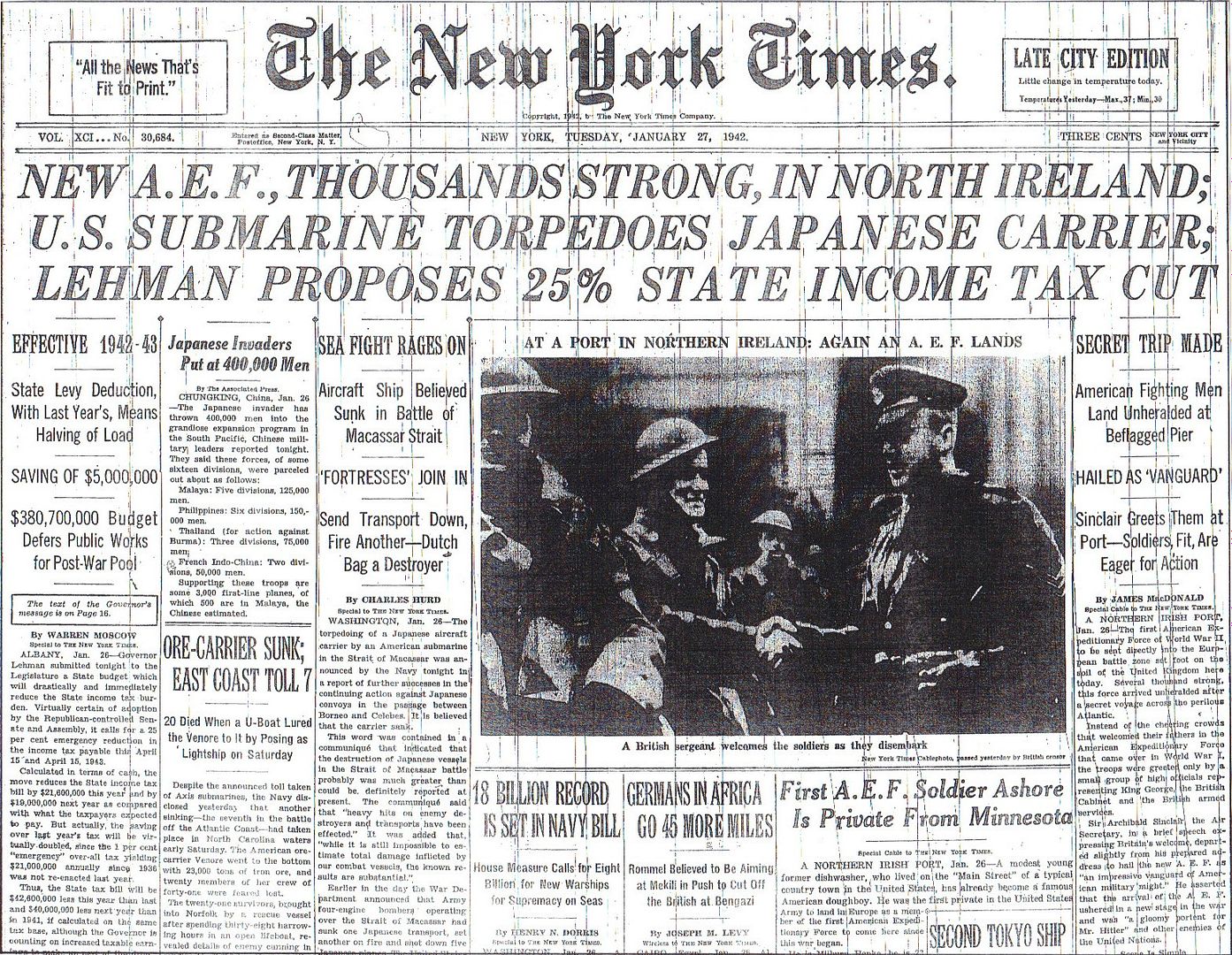
Posted on 01/27/2012 4:48:08 AM PST by Homer_J_Simpson

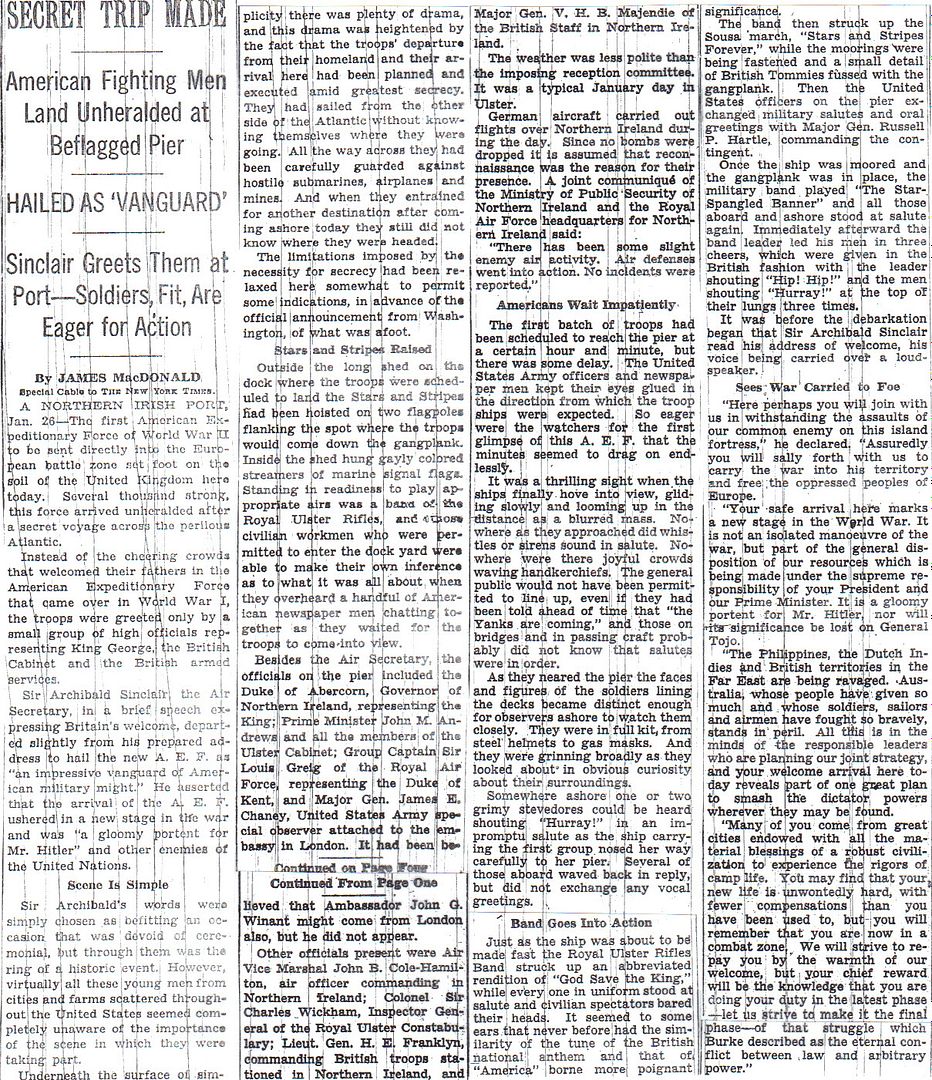
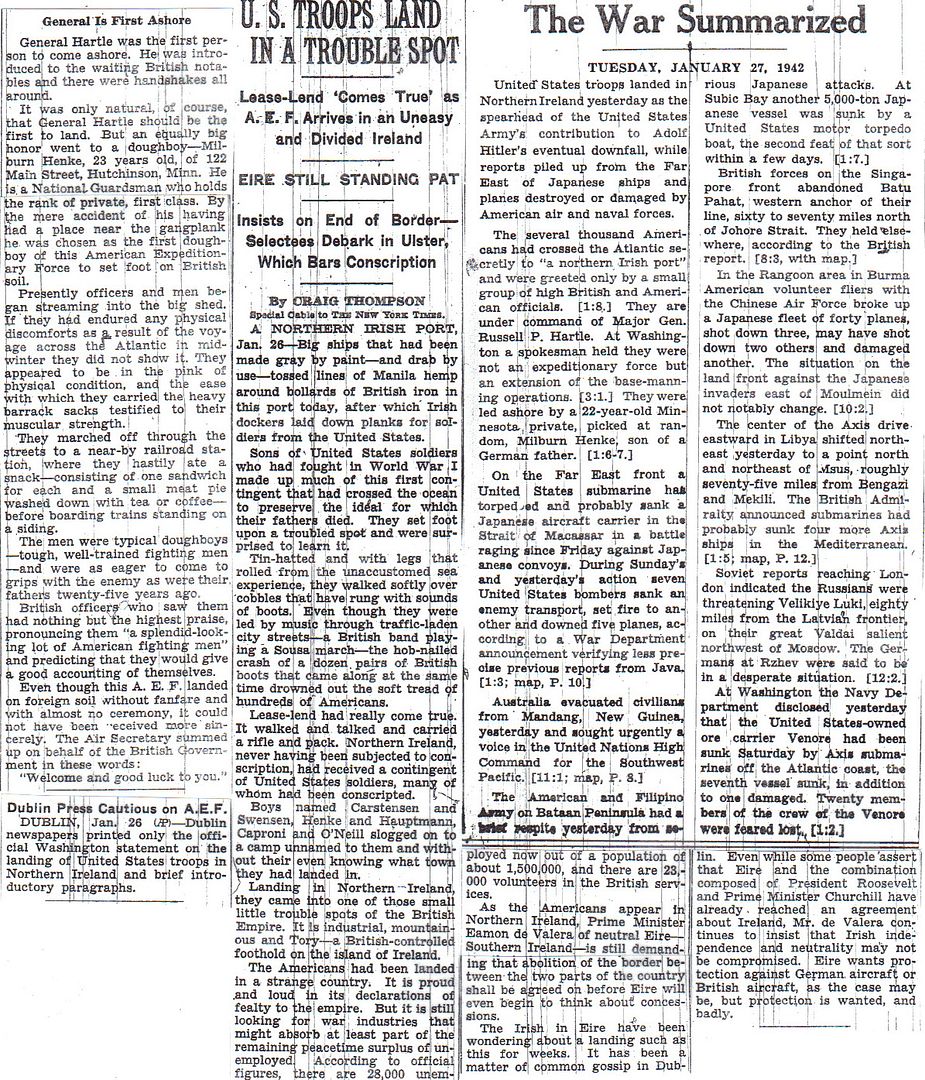

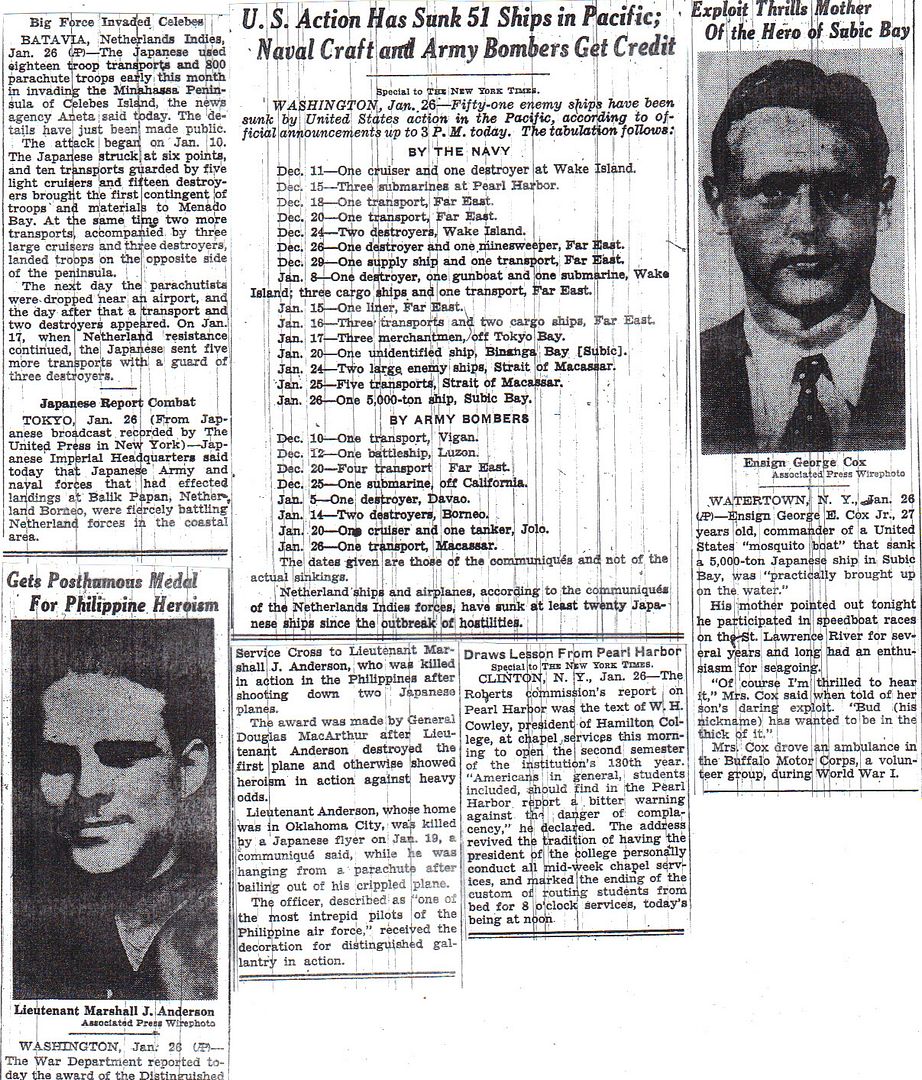
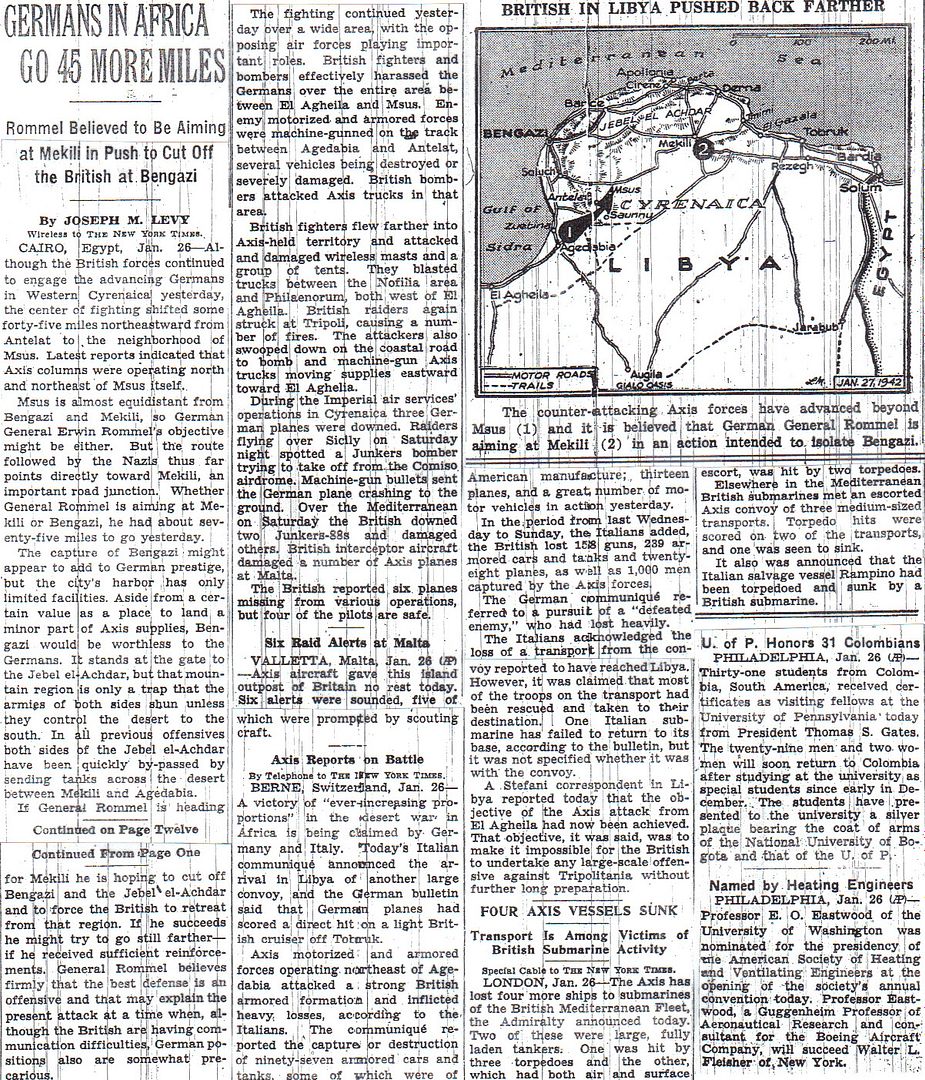
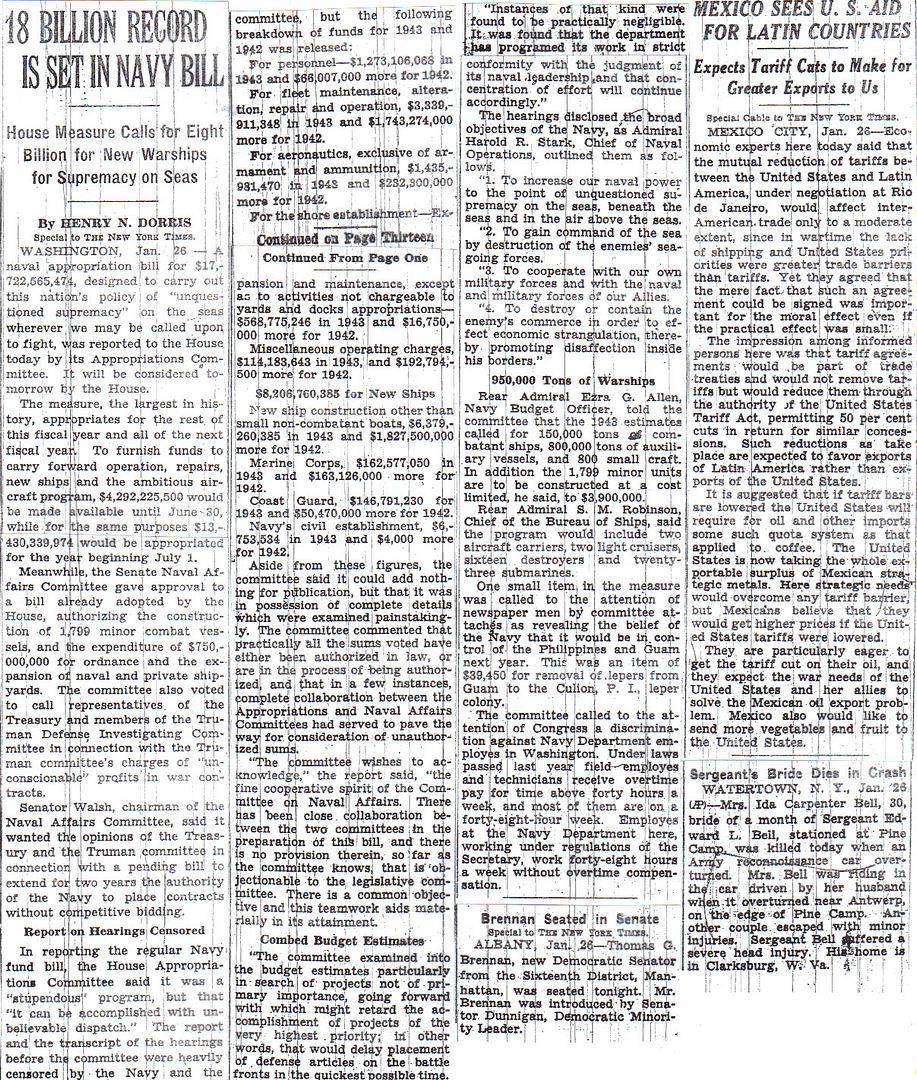
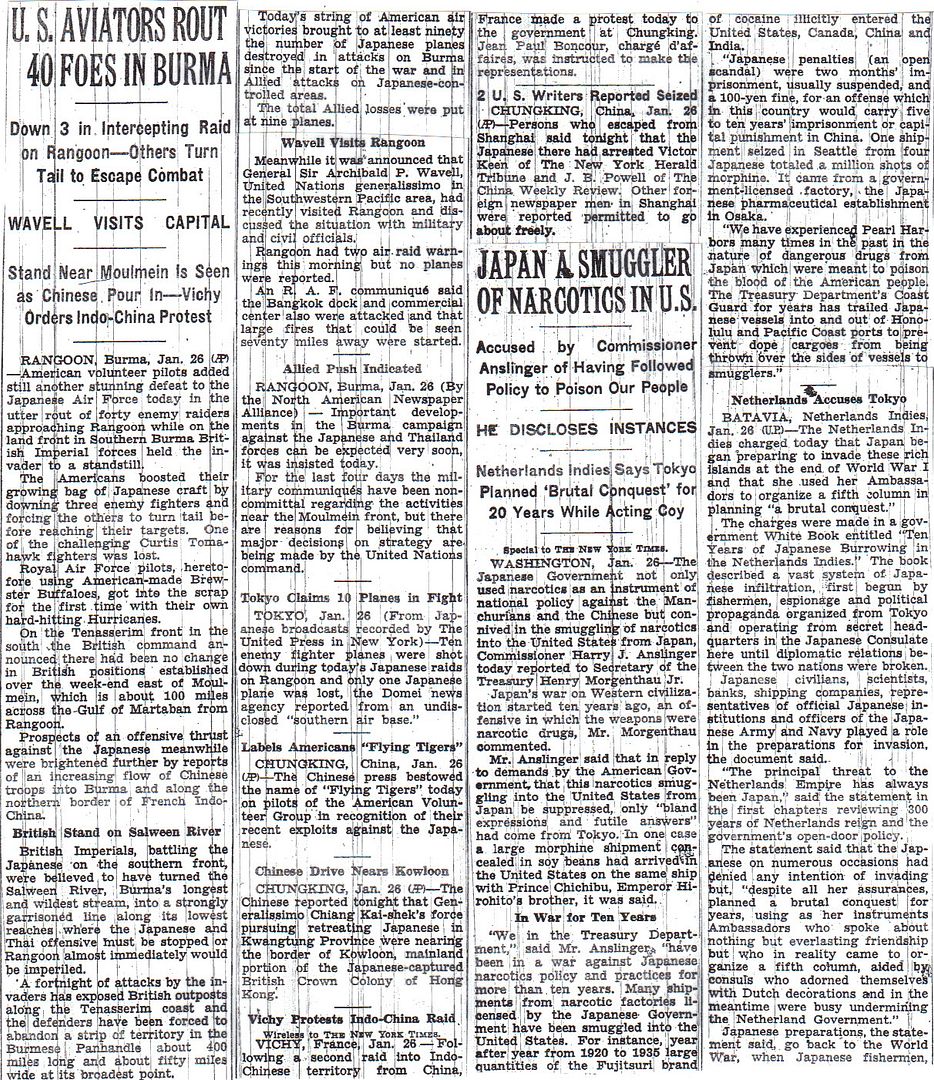
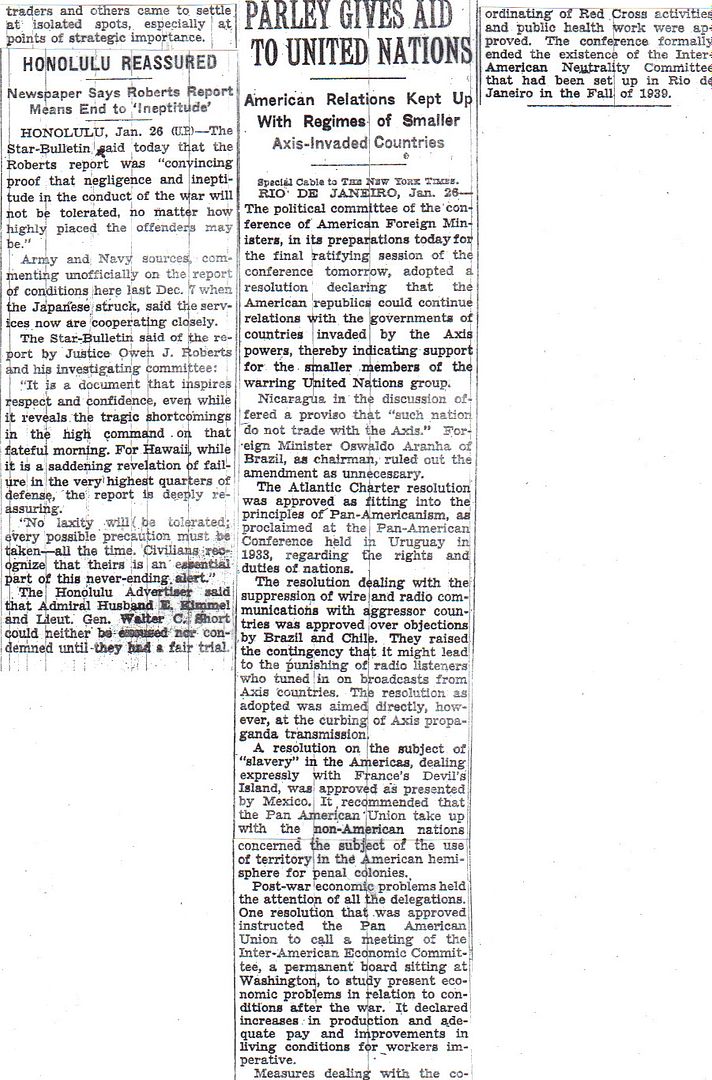
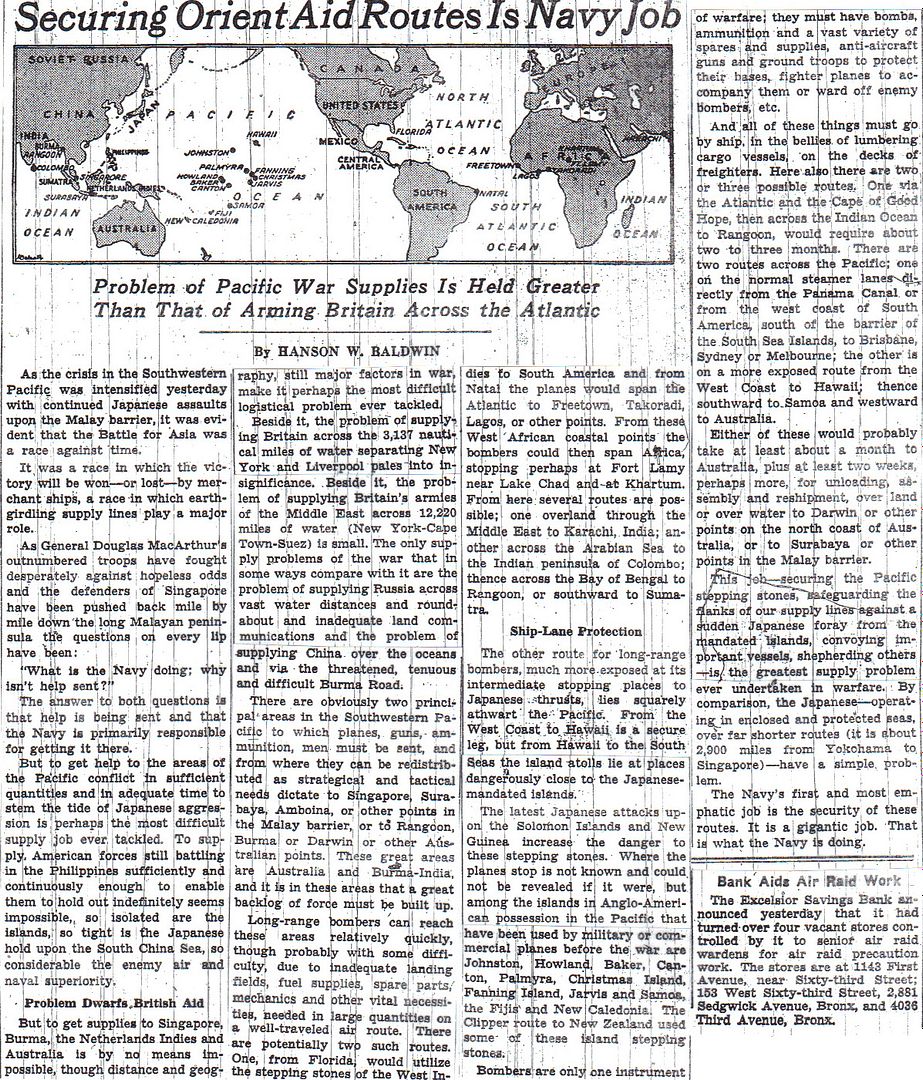
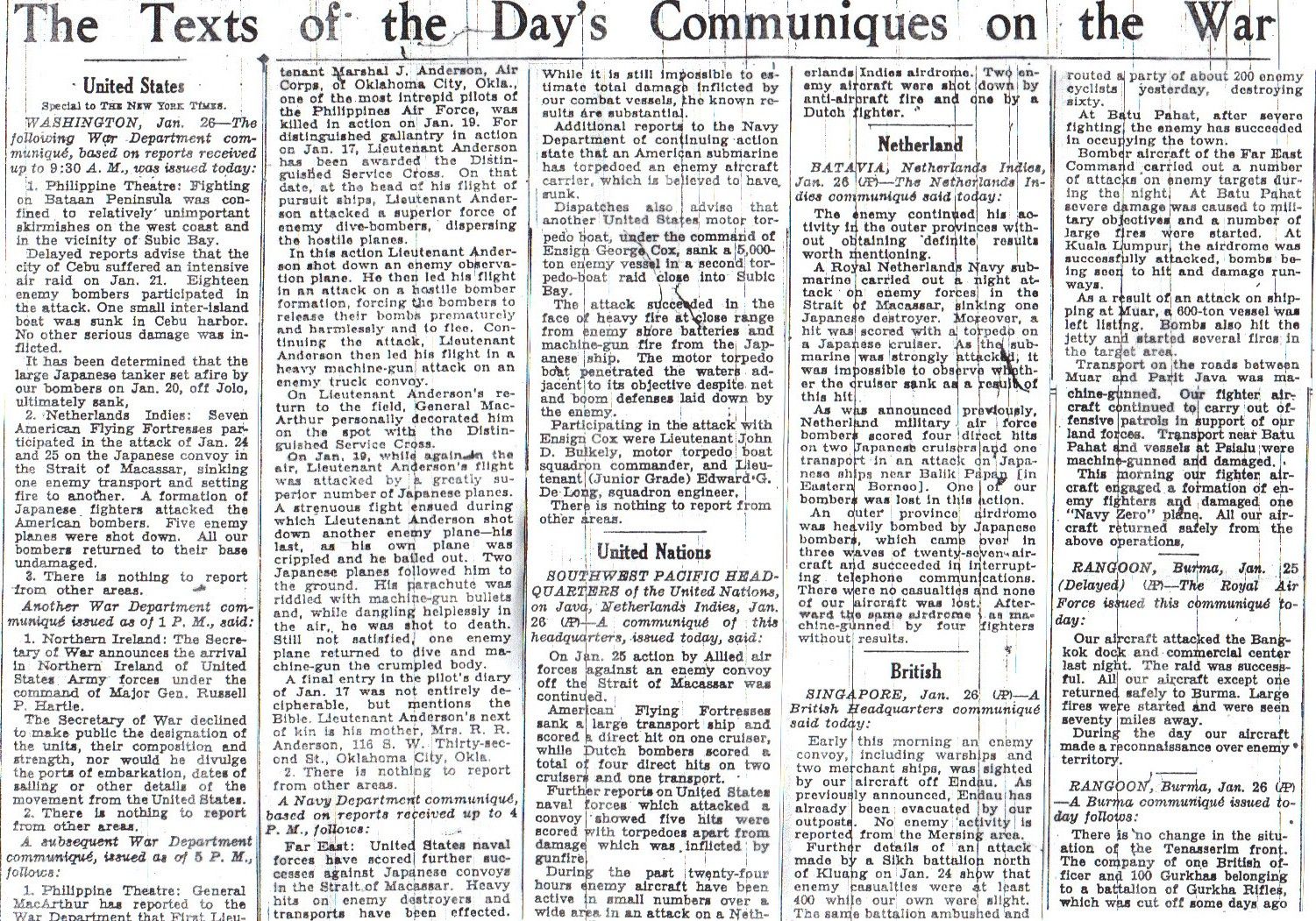

http://www.onwar.com/chrono/1942/jan42/f27jan42.htm
Red Army casualties mount in Ukraine
Tuesday, January 27, 1942 www.onwar.com
A knocked out T-26 and Soviet dead on the battlefieldOn the Eastern Front... Soviet troops, under General Timoshenko continue their advances into the Ukraine and capture Lozovaya. They now threaten Dnepropetrovsk, the main supply base for German Army Group South. German resistance is growing.
In London... Prime Minister Winston Churchill opens a major House of Commons debate with the report on Allied Cooperation. He details the Combined Chiefs of Staff, the Pacific Councils and the plans for the arrival of American land forces in Britain. The vote of confidence is opposed by one member of the House.
In Borneo... The Japanese land and capture Pemangkat and the airfield nearby.
In Malaysia... The British carrier Indomitable brings a cargo of 48 Hurricanes to Java, from here they be sent to augment the defenses at Singapore. The 22nd Indian Brigade is isolated by the fighting near Layang Layang, south of Kluang.
http://homepage.ntlworld.com/andrew.etherington/month/thismonth/27.htm
January 27th, 1942
UNITED KINGDOM: Westminster: Churchill announces the formation of a Pacific War council and a joint Anglo-US chiefs of staff committee, and that an Australian representative is to join the war cabinet.
Representatives of the Free French National Committee in London and of the United States had come to an agreement concerning the Allied military use of French possessions in the Pacific area. (Dave Shirlaw)
Prime Minister Winston Churchill opens a major House of Commons debate with the report on Allied Cooperation. He details the Combined Chiefs of Staff, the Pacific Councils and the plans for the arrival of American land forces in Britain. The vote of confidence is opposed by one member of the House. (Jack McKillop)
Lt. John McDonald Ruttan RCNVR was awarded the Distinguished Service Cross (DSC). The Citation, awarded as per the London Gazette of 27 Jan 42, read: “For bravery and endurance while minesweeping and when attacked by enemy aircraft.” John McDonald Ruttan worked in Port Arthur on the Port Arthur News Chronicle in 1937. He was recruited by LCdr. Rollo Mainguy into the Port Arthur Half Division of the RCNVR in Spring 1937. Ruttan served on the Canadian training schooner Venture in late Dec 37. He was assigned to the Winnipeg Division in the rank of Sub-Lieutenant in May 38. In Jun 40, he was sent to the Britain for a six-week basic officer’s course at HMS King Alfred and then the minesweeping course at Lochinvar. He was appointed as Executive Officer of HMS Skudd V (a converted Norwegian whaler) in Sep 40. Skudd V sailed for Alexandria in Oct 40 via the Cape and operated in the eastern Mediterranean, including Tobruk and Greece in 1941. Ruttan was promoted to Lieutenant on 16 Sep 41 and was appointed CO of a converted landing ship, HMS Svan, in Oct 41. Lt. Ruttan ‘hitch hiked’ home in 1942 in order to assume his new duties as Executive Officer of the minesweeper HMS Saint John. His next appointment was as Commanding Officer of the Landing Craft Infantry (Large) LCI(L)-302 in Feb 44, where he served through D-Day landings. His final appointment was as CO of the River-class frigate HMCS Matane from 20 Sep 44 to 03 Feb 45. He was demobilized on 13 Dec 45 and promoted to LCdr. while on retired list. John Ruttan died 21 Mar 92 in Ottawa. (Dave Shirlaw)
U.S.S.R.: In the Ukraine, on the Donets front, Soviet forces seize the important rail centre of Lozovaya, west of Izyum. They now threaten the main German supply base for Army Group South at Dnepropetrovsk. German resistance is growing. (Jack McKillop)
LIBYA:. South African reconnaissance aircraft spot Rommel’s diversionary move toward Mechili, and the British swallow the bait, moving 1st Armoured Division on the diversion. Axis forces renew their offensive from Msus, making their main effort toward Benghazi. (Jack McKillop)
AUSTRALIA: Minesweeper HMAS Latrobe laid down. (Dave Shirlaw)
BORNEO: Japanese troop occupy the towns of Ledo, Singkawang, Pemangkat, Sambas with its Naval Air Station, and Singkawang II airfield located near Ledo. All Dutch aircraft had been transferred to Sumatra prior to the Japanese invasion. (Jack McKillop)
USAAF Far East Air Force B-17 Flying Fortresses based in Java bomb and damage a Japanese seaplane carrier off Balikpapan. (Jack McKillop)
MALAYA: No. 36 and 100 Squadron’s RAF fly their last missions with the venerable Vickers Vildebeest biplanes against Japanese landings at Endau. (Peter Sinfield)
Destroyer HMS Thanet is sunk by gunfire from IJN destroyers off Endau on the east coast of Malaya at 02 40N 103 42E. (Alex Gordon)(108)
Lieutenant General Arthur Percival, General Officer Commanding Malaya Command, having received permission from General Archibald Lord Wavell, Commander in Chief Australian-British-Dutch-American (ABDA) Command, to retire to the 225 square mile (583 square kilometer) Singapore Island at his discretion, decides to withdraw at once through Johore Bahru and across the causeway to the island. Withdrawal is to be accomplished under cover of darkness and completed during the night 30/31 January. East Force meets no opposition as it pulls back. While elements of the Indian 11th Division’s Batu Pahat force fall back to Benut, the rest move to the mouth of the Ponggor River, from which they are withdrawn by sea during the following nights. West Force fights local actions while retiring along the main road and railroad. (Jack McKillop)
Off Endau, the destroyers HMAS Vampire and HMS Thanet encounter three Japanese destroyers and a minesweeper. HMS Thanet is sunk by gunfire but HMAS Vampire escapes to Singapore. The Japanese 96th Airfield Battalion completes their landing at Endau with much-needed supplies and ammunition. (Jack McKillop)
NETHERLANDS EAST INDIES: On Java, General Archibald Lord Wavell, Commander in Chief Australian-British-Dutch-American (ABDA) Command, tells Lieutenant General Sir John Lavarack, General Officer Commanding I Australian Corps, that he must hold Sumatra with one Australian division and central Java with another. (Jack McKillop)
The British aircraft carrier HMS Indomitable brings a cargo of 48 Hawker Hurricane fighters to Java, for shipment to Singapore. (Jack McKillop)
PACIFIC OCEAN: Submarine USS Gudgeon (SS-211) torpedoes and sinks Japanese submarine HIJMS I-73 240 miles (386 kilometres) west of Midway Island; the Japanese submarine had shelled Midway two days earlier. This is the first Japanese submarine sunk by a USN submarine. (Jack McKillop)
PHILIPPINE ISLANDS: In the II Corps area on Bataan, the Japanese begin an assault against the main line of resistance (MLR) in the afternoon. After a feint down the East Road, the main attack is made against Sectors C and D. Sector C is thinly manned and in the process of being reinforced by the 41st Infantry, Philippine Army (PA), from Sector D. The Japanese force the outposts back and get a small advance group across the Pilar River. In the I Corps area, the Japanese renew efforts to break through the MLR on the west coast and is again brought to a halt by the 91st Division, PA. In the South Sector, Lieutenant General Jonathan Wainwright, Commanding General I Corps, sends the 3d Battalion of the 45th Infantry, Philippine Scouts (PS), to Quinauan Point and the 2d Battalion of the 57th Infantry, PS, to Longoskawayan Point to dislodge or destroy the Japanese along the southwestern coast. Meanwhile, after preparatory fire from all available guns is conducted against Longoskawayan Pt, the infantry attacks but is unable to clear it. Scouts of 2d Battalion, 57th Infantry, relieve the naval battalion there during the night of 27/28 January. The Japanese are contained but cannot be cleared from Quinauan Point. Water-borne reinforcements for this position land short of their objective, between the Anyasan and Silaiim Rivers, before dawn and put beach defenders, the 1st Battalion of the 1st Philippine Constabulary, to flight. The ground echelon of the USAAF’s 17th Pursuit Squadron (Interceptor), from reserve, and the 2d Battalion of the 2d Philippine Constabulary, from the MLR to the north, move against the Japanese but are halted about 1,000 yards (914 meters) from the shore. The Japanese are ordered, upon reinforcing the Quinauan beachhead, to drive to Mariveles. (Jack McKillop)
Four USAAF Far East Air Force B-17 Flying Fortresses based in Java stage through Del Monte Airfield on Mindanao and attack Japanese targets on Luzon. One B-17 is shot down. (Jack McKillop)
Submarine USS Seawolf (SS-197) delivers ammunition to Corregidor Island, and evacuates naval and army pilots. (Jack McKillop)
PHOENIX ISLAND: The USAAF’s Hawaiian Air Force B-17 Flying Fortresses of Task Group 8.9 return to Canton Island. (Jack McKillop)
CANADA:
HMCS Sault Ste Marie (ex-HMCS The Soo) laid down Port Arthur, Ontario.
Minesweeper HMCS Milltown launched Port Arthur, Ontario.
Patrol vessel (ex-fishing vessel) HMCS Barkley Sound commissioned. (Dave Shirlaw)
U.S.A.: President Franklin D. Roosevelt announces that the Office of Price Administration (OPA) will ration all retail goods and commodities until the end of the war. (Jack McKillop)
Destroyer USS Saufley laid down.
Destroyer USS Rodman commissioned. (Dave Shirlaw)
ATLANTIC OCEAN: Two unarmed U.S. merchant tankers are attacked by German U-boat U-130: (1) one is torpedoed and sunk 90 miles (145 kilometres) northeast of Virginia Beach, Virginia and (2) one is torpedoed and damaged 20 miles (32 kilometres) east-northeast of Cape Hatteras, North Carolina. (Jack McKillop)
At 0203, U-123 opened fire with the deck gun at the unescorted motor tanker Pan Norway east of Cape Hatteras because no torpedoes were left. With the third salvo hits were scored in the engine room and the funnel. Even though the gun on the stern of the tanker was put out of action, the machine guns mounted on the bridge returned fire, hitting the conning tower and the deck several times. The U-boat then fired at the bridge, which caught fire after some hits. When the tanker stopped and the crew began to abandon ship, the fire was ceased. In between Hardegen had to clip the split lower lips of Ma-Gfr Bastel, who had been hit in the face by a empty ammunition case that fell through the open hatch and lost several teeth. After the crew had left the Pan Norway, the fire was reopened but soon no ammunition for the deck gun was left so they shot holes into the waterline with the 37mm AA gun until the tanker capsized and sank at 03.45 hours. Shortly before the duel began, they had spotted lights and the U-boat now went to investigate them. The lights belonged to the Greek steam merchant Mount Aetna, which was neutral because she operated in Swiss charter. Hardegen stopped the vessel and gave the direction to the survivors of Pan Norway. In a short time the merchant picked up 40 survivors including five wounded and the U-boat rescued another wounded man, took care of him and after a short interrogation placed him aboard the neutral vessel, whose master expressed his thanks and wished the U-boat a lucky return journey. The survivors were landed at Lisbon on 6 February.
At 0943, the unarmed and unescorted steam tanker Francis E. Powell was hit by one torpedo from U-130 about eight miles northeast of the Winter Quarter Light Vessel, while proceeding completely blacked out at 10.5 knots. The torpedo struck on the port side aft of the midships house, between the #4 and #5 tanks. The explosion started a small fire in the pump room and destroyed the radio antenna. Then the U-boat was sighted a few hundred yards away. The eight officers and 24 crewmen abandoned ship in two lifeboats. The master was crushed to death when he slipped and fell between the boat and the ship. The same boat was lifted back on the ship by a wave and the occupants had to launch another boat. Another officer and two men were also lost. The tanker sank at about 1400. After five hours, 17 men in one of the boats were picked up by the American steam tanker W.C. Fairbanks and landed at Lewes, Delaware. The remaining eleven survivors in the other boat were picked up by a USCG boat from the Assateague Station and landed at Chincoteague VA.
Steam tanker Halo shelled and damaged by U-130.
At 0021, U-754 fired a spread of three torpedoes at SS Icarion, dispersed from Convoy ON-53, and observed a hit in the stern after 5 minutes 25 seconds. The ship sank at 01.08 hours. (Dave Shirlaw)
The history of the battle of the Demyansk pocket—a battle lasting twelve and a half months and hence ranking as the longest battle of encirclement on the Eastern Front—began on 8th February 1942.
Count Brockdorff-Ahlefeldt, the general commanding II Army Corps, was on the telephone to Sixteenth Army. "We'll try to keep communications open with you at all costs," Colonel-General Busch was saying. At that moment there was a click in the receiver. The two generals heard the cool voice of the operator at the Corps exchange cut in: " I'm disconnecting now: the enemy's in the line."
The general replaced the receiver. He looked at his ADC and said, " That was probably the last talk we've had with Army for some time to come."
" That means the ring is closed?" the ADC asked.
" Yes," replied the general. After a short pause he added, " At least we know where we are. We'll just have to wait and see."
" Waiting and seeing " turned out to be twelve months and eighteen days of ferocious fighting. The Corps was now encircled in an area of 1200 square miles.
The reasons why this battle had to be fought, why a pocket in the middle of the Valday Hills around the dismal dump of Demyansk had to be held against the Soviet assault, were explained by the general in an unusual Order of the Day. Unusual because it not only ordered the officers and men to do a certain thing, but also explained the circumstances and reasons for the order. On 20th February, therefore, twelve days after they had first been encircled, Count Brockdorff-Ahlefeldt had the following order read to all his formations in the pocket:
"Taking advantage of the coldest winter months, the enemy has crossed the ice of Lake Ilmen, the normally marshy delta of the Lovat river, and the shallow valleys of the Pola, Redya, and Polist, as well as numerous lesser watercourses, and placed himself behind II Corps and its rearward communications. These river-valleys form part of an extensive area of swampy lowlands which get flooded and entirely impassable, even on foot, the moment the ice and snow begin to melt. Any enemy transport, especially the bringing up of supplies on any scale, will then be entirely impossible. Russian supplies during the wet spring-time would be possible only along the major hard roads. The intersections of these roads, however—Kholm, Staraya Russa and Demyansk—are firmly in German hands. Moreover, the Corps with its battle tried six divisions commands the only real piece of high ground in the area. It is therefore impossible for the Russians with their numerous troops to hold out in the wet lowlands without supplies in spring. What matters, therefore, is to hold these road junctions and the high ground around Demyansk until the spring thaw. Sooner or later the Russians will have to give in and abandon that ground, especially as strong German forces will be attacking them from the west."
The officers and men listened and nodded. They understood. They were determined to hold " the county," as they called their pocket in an allusion to their general's title.
The battle began. It was the first major battle of encirclement in which the German troops were the encircled. For the first time in military history an entire Corps of six divisions with roughly 100,000 men—virtually a whole Army —was successfully supplied by air. It was on the Valday Hills in Russia that the first airlift in military history went into operation.
Some 500 transport aircraft supplied the 100,000 men of II Corps with everything they needed for survival and fighting—day in, day out. The machines flew regardless of blizzards and frosts, of fog or winter thunderstorms, and regardless of the furious anti-aircraft fire of the Soviets. About 100 aircraft had to make the flight into the pocket and back each day. On certain days there were as many as 150. This meant that during every hour of the short winter days 10 to 15 aircraft had to land and take off from the two makeshift airstrips.
The feats of these transport units under Colonel Morzik, the Chief of Air Transport, were unparalleled at the time. The scope of the operation is illustrated by two figures: 64,844 tons of cargo were flown into the pocket and 35,400 men—wounded or transferred—were flown out. The airlift was a decisive contribution to success. But it also mortgaged future German strategy: the German transport squadrons were decimated. Many pilots were killed. More disastrous still was the fact that the success at Demyansk confirmed Hitler in his decision, nine months later, to hang on to Stalingrad, because he believed he would be similarly able to keep the encircled Sixth Army with its approximately 300,000 men supplied from the air.
Major Ivan Yevstifeyev, born in 1907, commanded the famous 57th Brigade, the spearhead of the Soviet Second Striking Army, on the Volkhov. He was an outstanding officer, courageous, a skilful leader in the field, and with the full background of a Soviet General Staff training. When he was taken prisoner he remarked, "It was bound to happen like this, with so much stupidity in our Supreme Command." The report which he wrote shows that the news of the Second Striking Army being pinched off at the bottleneck of the clearing Erika had had a disastrous effect in Moscow.
It meant the shattering of Stalin's hopes of liberating Leningrad and annihilating the German Army Group North. Stalin was looking for a scapegoat. And just as he had dismissed General Sokolovskiy, the Army Commander-in-Chief, during the first week of January for attacking on a broad front and not breaking through, so General Klykov and his Chief of Staff were now sacked because they broke through on too narrow a front. But who was to save the situation now? Who could blow out the bung from the bottleneck and free the bulk of the two Armies encircled in the huge pocket?
Stalin's choice turned out to be a man who was then one of the stars of the Soviet Generals' Corps—Andrey Andreyevich Vlasov.
In the late summer of 1941 Vlasov had courageously defended Kiev for two months, and subsequently, as Commander-in-Chief Twentieth Army, thrown back the northern wing of the German offensive against Moscow at Solnechnogorsk and Volokolamsk. He had been rewarded with orders, praise, fame, and the position of a deputy Commander-in-Chief of the Army Group Volkhov. Now he was to go into action again to prove his generalship.
Vlasov was the son of a small peasant, born in 1901. At considerable sacrifice his father sent him to a priests' seminary. Lenin's revolution decided him to become a Communist, to join the Red Army, to become a regular officer and eventually a general. Owing to the fact that during the thirties he was in China as Chiang Kai-shek's military adviser, he escaped the great purges which claimed Marshal Tukhachevskiy and most of his friends as victims.
When Vlasov eventually returned to Russia there was no limit to his career. Very soon his fame as an organizer was proclaimed throughout the Soviet military Press. The man who had once changed the 99th Rifle Division from the most notorious riffraff in the Red Army into a crack unit had now been chosen to save the two surrounded Armies.
Before dawn on 21st March Vlasov was flown into the Volkhov pocket and assumed command of the seventeen divisions and eight brigades in the forests between Chudovo and Lyuban. He immediately set about battering down the bolted door from inside. At the same hour as Vlasov had summoned his unit commanders to a forester's cabin east of Finev-Lug to discuss the bursting of the German ring of encirclement around the Soviet Second Striking Army on the Volkhav, some hundred miles to the south-east the German Colonel Ilgen reported at Lieutenant-General Zorn's headquarters in Fedorovka in the Demyansk pocket to learn the plan for breaking through the Russian ring around the six German divisions in the Demyansk pocket. It was a strange parallel.
" Today's the first day of spring, Herr General," Colonel Ilgen said with a smile.
General Zorn was standing outside the crooked wooden building which served as the Corps Group's headquarters. " Spring indeed," he grunted, " with two feet of snow and 30 degrees below."
" Well, that's what spring's like in Demyansk," Ilgen grinned.
" You're right," Zorn nodded. " But joking apart, Ilgen, I hope the frost continues for a while. Once the thaw comes the mud will be terrible-not a wheel will be able to turn. And Seydlitz has got to get here before then."
The crimson disc of the morning sun broke through the haze of the new day. From the distance, from the sector of 290th Infantry Division at Kalitkino and of the Combat Group Eicke at the extreme western point of the pocket, came the flashes of Soviet heavy artillery. Zorn glanced at his watch. "0730," he said. " Now Seydlitz is mounting his attack."
At that moment, 25 miles away, south-east of Staraya Russa, the guns opened up along a six-mile front. They put down a heavy barrage. Stukas roared and screamed above the Russian lines. And then the regiments of General von Seydlitz-Kurzbach's Corps Group charged ahead—just as in the old days of the summer offensive. " Operation Bridge-building," the German offensive to relieve II Corps in the Demyansk pocket, had begun. The ring around Count Brockdorff's Corps had been closed for forty-one days. Only 25 miles separated " the county " from the German main fighting-line. The encircled six divisions had to defend a front line of nearly 190 miles: they were clearly not strong enough to hold a continuous line everywhere, and many sectors were defended only by intermittent strongpoints. Apart from their numerical weakness, the defenders were suffering from the exceedingly tight food situation. The 96,000 men and roughly 20,000 horses had to be supplied by air. Rations had been reduced nearly by half.
Obviously the supply planes could not carry any hay or straw for the horses. Thus, in spite of the ingenuity of their attendants, the animals were getting thinner and thinner. The rotten straw of the wrecked peasant shacks was no adequate substitute for fodder. True, the animals were supplied with tree bark, pine branches and needles, reeds, and beans, but this did not assuage their hunger. They ate the sand and died of sand colic. They went down with mange, founder, and other diseases. The veterinary surgeons fought for every animal's life, but frequently the coup de grâce was all they could prescribe. Thus the horses performed their last service in the field kitchens.
The Russian civilian population inside the pocket used to come and collect the bones and entrails. Nothing was left, except the hooves. All this was now to end.
General von Seydlitz-Kurzbach was mounting his attack from Staraya Russa, in the strength of four divisions, in order to blast a corridor through to the Demyansk pocket and reunite the cut-off divisions with the main fighting-line. Meanwhile in the western salient of the pocket the " Corps Group Zorn " had been formed: at the appropriate moment it was to launch a break-out—" Operation Gangway "—in order to meet Seydlitz's divisions half-way. The spearhead of this operation was to be provided by Colonel Ilgen's regiment, which had been put together from various battalions of the surrounded divisions. " What then is the general plan, Herr General, and when is zero hour?" Colonel Ilgen asked.
With his walking-stick General Zorn drew the outline of the Demyansk pocket in the snow. Left of it he drew an arc indicating the main front at Staraya Russa. " Count Brockdorff has informed me that Seydlitz's Group is mounting its attack from the Staraya Russa front with four divisions." And General Zorn added four arrows to his sketch-map in the snow.
" Here "—he indicated the two arrows in the middle—"are the Silesian 8th and the Württemberg 5th Jäger Divisions, carrying the main weight of the attack. Both these divisions were brought to the Eastern Front from France at the beginning of the year, and both have experience of active service. The Ulm Jägers, in particular, fought superbly well in the heavy battles at Staraya Russa at the beginning of February." Zorn pointed his stick to the right and to the left. "The flanks of the relief attack will be covered by 329th Infantry Division on the right and 122nd Infantry Division on the left. Seydlitz's Jäger Divisions will be aiming directly at this point, the westernmost point of our pocket, at Kalitkino and Vasilkovo. The moment he gets to the Lovat crossing at Ramushevo, along the Staraya Russa-Demyansk road-in other words, when he is still 8 miles away-we attack. Your task, Ilgen, will be to tear open the Russian positions outside our pocket and to reach the Lovat at Ramushevo."
Ilgen nodded. The snow was sparkling under the morning sun. From afar came the rumble of guns. An orderly came running from the building: " Telephone, Herr General."
At first everything went according to plan. After the preliminary artillery bombardment and the concentrated use of Stukas, Seydlitz's offensive moved smoothly, just as during the first few weeks of the Blitzkrieg. Presently, however, the difficulties began. The wintry forest and scrub east of Staraya Russa slowed down the momentum of the advance. Russian defenses in depth, consisting of five systems of positions, had to be pierced. Progress was only a step at a time—and that required courage and cunning, and blood and tears. No quarter was given and neither side took prisoners. The fighting continued for four weeks. It began in a temperature of 30 degrees below, over swamps frozen as hard as stone. A few days later the thermometer rose to freezing-point. The thaw came. Everything sank into the morass. By the end of March the temperature was down again to 20 degrees below. In daytime there were heavy snowfalls, and at night the swamps and forests were swept by icy spring gales which instantly froze any living thing that had not sought shelter in a cave, in a hut, in a hole in the ground, or under hurriedly felled tree-trunks.
In April the weather broke for good. Snow and ice melted. The water was knee-deep on the roads. The men waded waistdeep through the icy swamps and marshes. Rafts had to be built for the heavy machine-guns from branches of trees and bushes, or otherwise they would disappear in the mud. The wounded had to be laid on stretchers made of branches, or else they would have drowned. Anything that weighed anything—rifles, horses, and men—sank into the swamp. The men's uniforms were sodden. And in the thick scrub the enemy was lurking. The Russians too suffered greatly from the mud. Their heavy tanks were unable to intervene, and their artillery was immobilized.
On 12th April Seydlitz's spearheads caught sight of the shattered towers of Ramushevo, rising like a mirage through the haze and smoke. They had reached their objective. "Operation Bridge-building," they knew, would stand or fall with the possession of Ramushevo. For this small town controlled the road and the crossing over the Lovat, which, now the spring thaw had set in, was once more a major obstacle.
The following day Colonel Ilgen was severely wounded while reconnoitering in preparation for his attack. His regiment, for whose attack he had made the most painstaking preparations, was taken over by Lieutenant-Colonel von Borries. The attack was mounted at dawn on 14th April. Six days later, on 20th April, the battalions reached the first houses of Ramushevo on the eastern bank of the Lovat at nightfall.
The forward units consisted of the reinforced SS Panzerjäger Battalion of the " Death's Head " Regiment under Hauptsturmführer [Major] Bockman. On the far bank the western part of the town was blazing. Tracer bullets streaked through the night. The noise of battle came over the river. The river was in full spate and more than a thousand yards wide. It was impossible to see what was happening on the far side: the smoke, the dust, and the glare of the fires reduced visibility to nil. It was the same throughout the next day.
Seydlitz's companies were fighting furiously for a stretch of riverbank. At nightfall Borries's men caught sight of figures with German steel helmets waving from the other side. " They're here! They're here!"
The time was 1830 hours on 21st April 1942. Only the turbulent Lovat now separated the corridor which would reunite the encircled regiments with the main fighting-line. Demyansk, the powerful breakwater on the Valday Hills, had performed its duty. For several months six German divisions had barred the way to the Soviet Armies. Now they were once more part of a continuous front.
And what was the situation at Kholm, 55 miles farther south?
For the past hundred days General Scherer's combat group with about 5000 men had been holding the road junction in the middle of the vast swampy area, the strongpoint and crossing on the upper Lovat, commanding both the river and the hinterland. Kholm, the only solid point in the torn front line between Velikiye Luki and Demyansk, the bolt on the backdoor to the Sixteenth Army, was halting the Soviet drive to the west just as Demyansk was holding the Soviet wedge driving to the south.
The small provincial town with its 12,000 inhabitants had become a front-line town overnight. Supply troops and scattered units of divisions of the line had been organized for its defense. Major-General Scherer, the commander of 281st Local Defense Division, had been appointed Fortress Commandant. His instructions were to hold Kholm at all costs.
Kholm was held. Its defense has gone down in military history as the story of a highly creditable performance, a story of courage, military improvisation, and soldierly bearing. The Combat Group Scherer was a motley crowd. It consisted of units of 123rd Infantry Division, of the 218th Infantry Division, which had only just been transferred to the Eastern Front from Denmark, and of the 553rd Infantry Regiment, 329th Infantry Division. There were also Mountain Jägers from Carinthia and Styria organized as Commando 8, then the 3rd Battalion, 1st Luftwaffe Field Regiment, and the Reserve Police Battalion 65 of 285th Local Defense Division. There was even a naval motor-transport unit. From these groups of varying sizes Colonel Manitius, commanding 386th Infantry Regiment belonging to 218th Infantry Division, the Operations Commandant, molded an efficient fighting force of which he himself was the soul and inspiration.
On 28th January Kholm was fully encircled. Parts of the Machine-gun Battalion 10 managed to get inside the pocket a little later, but behind them the trap sprang shut for good.
The fortress area measured barely a square mile, and later shrank to only about half a square mile. It was held by 5000 to 5500 men. In parts, the front of the pocket ran right through the middle of the town. The men knew every house, every ruin, every tree, and every bomb-crater between the northern cemetery, the hairpin bend, the GPU prison, and the police-station ravine. These were the four most notorious strongpoints of the fortress. The town was being besieged by three Soviet rifle divisions, who charged day after day.
The defenders could be supplied only from the air. In a field outside the front of the pocket, in no-man's land, sappers built a makeshift airstrip measuring 70 by 25 yards. Every single landing was an adventure. And most of the JU-52s were damaged in the attempt. Before long the field was dotted with wrecks of aircraft. The Luftwaffe therefore switched over to sending personnel and heavy equipment by freight-carrying gliders and dropping foodstuffs and ammunition in containers. Anxious minutes invariably followed the appearance of a JU or two with gliders from over the edge of the forest in the west. If the gliders were cast off only a few seconds too soon they would land among the Russians and be slaughtered, or even worse, captured. Even if a glider touched down in the correct spot an ever-ready assault detachment had to secure the precious consignment as quickly as possible. For, needless to say, the Soviets were also lying in wait for these prizes. Frequently the two sides would race each other to the point where the freighter had crash-landed.
Eighty freight gliders landed in the Kholm pocket. Twenty-seven JUs were lost in the supply runs. But being entirely supplied by air was not the most typical or most unusual thing about Kholm. Far stranger still was the fact that Kholm was a fortress without artillery.
A few 8-cm. mortars, some 3.7-cm. anti-tank guns, and one 5-cm., as well as two light infantry guns—that was all the heavy equipment inside the pocket. There were no heavy guns or howitzers. How then was the fortress able to hold out against a powerful enemy attacking it with guns and tanks? How could a fortress hold out even for a few days without its most vital weapon—the fortress artillery?
In Kholm this problem was solved in a manner that is probably unique in military history. The fortress artillery was emplaced outside the fortress, but its fire was directed from within. The guns which pounded the Soviet concentrations by day and night, the artillery barrages which came down to protect the German lines whenever the enemy charged—all these came from heavy batteries standing at the end of a narrow corridor which General von Uckermann's combat group had driven to within 6 miles of Kholm, straight through enemy country. Against all the rules of military practice these batteries of 218th Artillery Regiment and Heavy Artillery Battalion 536 were emplaced at the end of this corridor, as if on a proffered dish, firing for all they were worth.
In Kholm itself First Lieutenant Feist and Second Lieutenant Dettmann acted as forward observers and directed the fire by manually keyed telegraphy. On some days more than 1000 heavy-calibre shells would roar overhead, across Kholm, into the Russian positions or into charging enemy formations. The forward observers in Kholm, the artillery officers and their signalers, gradually developed such skill that even individual attacking Russian tanks were shelled and knocked out by direct hits.
The Soviets were determined to take Kholm before the onset of the thaw. They wanted to get past this accursed barrier which was holding up an entire Army. On some days, therefore, they launched as many as eight attacks. They would make penetrations. They would be thrown back again in fierce hand-to-hand fighting. They would come again. They would occupy a ruin here, a snowdrift there, or a bomb-crater. An immediate counter-attack would be launched with hand grenades and flame-throwers. Thus it went on day after day. Among the German combat groups there were specialists in the lobbing of hand-grenades who could hit pin-point targets, and there were tank-wreckers who performed their task with the unruffled expertise of spider-men working on tall buildings.
The incipient thaw with its mud and slush imposed a temporary halt on the Soviet attacks, but it also made life inside the pocket unbearable. In the cellars of the ruined houses 1500 wounded were lying on the bare floors; a few lucky ones were bedded on planks. Their lot was far worse than that of the 700 wounded who were flown out of the pocket. Doctors and medical orderlies under the command of Dr Ocker worked until they dropped. Dr Huck, the surgeon, risked the boldest operations in an attempt to save the lives of badly wounded men. But the dirt and the lice were almost more dangerous enemies than the Russian shells and exacted a heavy toll. The situation is illustrated by two figures: there were 2200 wounded and 1550 dead.
On 12th March Second Lieutenant Hofstetter made the following entry in his diary: " The first case of typhus." There it was, the spectre of all besieged fortresses—typhus.
Vaccine was dropped. Medical personnel and doctors spent every free minute inoculating the men. War was declared on the lice. The race against time began.
Then came the news: hold on—divisions under General von Arnim are on the way to get you out. But on 1st May it seemed as though all the heroism and all the sacrifices had been in vain. The Russians mounted their full-scale attack. First an artillery barrage— then the tanks. And after them the infantry. "Urra!"
The eastern end of the front snapped. The Russians were within a hundred yards of the Lovat. If they succeeded in covering these hundred yards that would be the end, for they would hold the higher river-bank and would be able to crack the fortress from inside. But they did not manage it. They were stopped by the Stukas, by Uckermann's guns, and by the sangfroid of Scherer's men.
One of these men was Sergeant Behle with his 5-cm. antitank gun at the southern cemetery. His optical sight was out of action. Five Soviet tanks were approaching. Behle aimed by looking down the barrel. He shoved in the shell. He slammed the breech shut. He fired. A loud crash—a direct hit. Behle fired twenty rounds. Not one of the five tanks got past him. The fifth was stopped only 40 yards in front of his gun.
On the airstrip Sergeant Bock was lurking behind cover with his anti-tank rifle. Standing, his barrel supported on a piece of masonry, he knocked out four Russian light tanks. All was quiet on 2nd May. But on 3rd May action began again at 0300 hours. It was a rainy, hazy day. The German aircraft could not take off. But the men in the pocket could hear the approaching noise of battle from the south-west. " Those must be our chaps," they called out to each other. The hope lent them new strength. They must not give in now.
On 4th May they saw German Stukas dropping their bombs just outside their pocket. They were blazing a trail for the relieving units. On 5th May the weather was again hazy. A runner came bursting into Captain Waldow's command post. " Herr Rittmeister, two German assault guns!" A moment later the soldiers could hear the clank of the tracks. Doubled forward, the grenadiers were advancing alongside the steel monsters camouflaged with twigs and branches. " Are they really our men? Or is this a Russian trick? Careful!" But now they were here, the steel-helmeted men and the self-propelled guns of the "Greif" Battalion under Lieutenant Tornau and the sappers of Lieutenant-Colonel Tromm's 411th Infantry Regiment, a unit of 122nd Infantry Division. Second Lieutenant Dettmann, describing the scene, says, " The men were received with wonderment, like visitors from another planet."
The relief came at the eleventh hour. There were only 1200 men left in the firing-pits, the trenches, and the ruins. Some 1500 wounded were cowering in their miserable quarters. About the same number of dead lay buried between the positions. Lieutenant-Colonel Tromm joined them at the last moment: he was hit by a Soviet shell.
Kholm was once more part of the German front, part of the main fighting-line in the stabilized area south of Lake Ilmen. From then onward that line held until 1944.
WHAT had happened in the meantime on the Volkhov, where Vlasov's Second Striking Army had been cut off in the forests? Here, too, spring had come. The snow had melted away, and the ice on rivers and swamps had thawed. In the dugouts and trenches the water stood waist-high. In the dead forests thousands of millions of midges woke to new life. Where columns on sledges and skis had darted swiftly only a short while before there were now water-courses and throbbing swamps. And in the very midst of this hell was General Vlasov with his fourteen Soviet rifle divisions, his three cavalry divisions, his seven rifle brigades and one armored brigade—an Army in the swamp.
Vlasov was an energetic general. On 27th March he had burst open the German barrier in the clearing Erika by striking at it with Siberian assault brigades and tanks from the west. Admittedly, the gap they punched was only a mile wide, but nevertheless it was a gap through which the encircled units could be supplied. In vain did the battalions of the German 58th Infantry Division and the SS Police Division try to drive Vlasov's Siberians out of the clearing. They did not succeed.
They were too weak themselves, and the swampy and wooded ground on both sides of the clearing Erika was too difficult to allow the bringing up of sufficiently strong formations to seal off the Soviet pocket completely. As a result, the 58th Infantry Division and the group holding the area north of it had to stand up to continuous Soviet attacks throughout six difficult weeks. At last, at the beginning of May 1942, a second, carefully prepared attack by the 58th Infantry Division, which had by then been reinforced, resulted in success—i.e., in a solid linkup with the Police Division employed to the north of the clearing Erika.
At that stage Vlasov decided to break out of the hell of the Volkhov swamps. But by then his regiments were no longer able to cross frozen marshes or make their way through the thick forests. The marshy forest floor and the swamps forced them to keep to roads and paths. And there was only one path open to them —the wooden causeway across the clearing Erika.
On 20th May General of Cavalry Lindemann issued an Order of the Day to his Eighteenth Army. It opened with the words: " The Russians are pulling out of the Volkhov pocket."
It was like a signal for the German men fighting on the Volkhov. On that 20th May they once more sealed the gap across the clearing Erika, Throughout the heavy fighting of these months the infantrymen, the gunners, and Panzerjägers were helped by the sappers of Engineers Battalion 158 under Captain Heinz. Day and night, under the most difficult conditions, the men were in action. Their casualties were heavy. At the end of the battle, when the gallant battalion was pulled out, the combat strength of its three sapper companies was down to three officers, three NCOs, and thirty-three men. The commander of the 2nd Company Engineers Battalion 158, Second Lieutenant Duncker, a parish priest in civilian life, was awarded the Knights Cross in recognition of the part he played in the successful fighting at the clearing Erika.
By the end of May 1942 the savage battle on the Volkhov had been won by the German troops. Those units of Vlasov's Army which had not succeeded in slipping out were now irretrievably caught in the trap. They were nine rifle divisions, six rifle brigades, and units of an armored brigade. The end of the Soviet Second Striking Army was at hand.
That end was frightful. Only 32,000 men survived the battle, and they were taken prisoner. Several tens of thousands were lying in the forests and swamps—drowned, starved to death, bled to death. It was an appalling field of slaughter. Huge swarms of flies buzzed over the marshes and over the corpses which were sticking out of the swamp. A terrible stench hung over the clearing. It was hell itself.
Through that hell roamed General Andrey Andreyevich Vlasov with his staff.
The Germans were after him. Suddenly the general had vanished. Where was he? Had he been killed? Had he shot himself? Or was he hiding out?
Vlasov's description, complete with photograph, was dropped by German aircraft in many thousands of leaflets over the villages of the Volkhov pocket. High rewards and special leave were promised for his capture. Naturally, from that moment onward reports were coming in every day: Vlasov has been seen; Vlasov has been found dead; Vlasov has been taken prisoner. On being followed up the reports invariably proved to be based on mistakes, empty boasts, and misunderstandings. On 11th July yet another report arrived at XXVIII Corps to the effect that Vlasov had been found dead. Captain von Schwerdtner, the Intelligence Officer, set out at once. He found a dead officer covered with a general's greatcoat. He was about six foot two tall—about Vlasov's height. But it was no longer possible to identify the body or to establish any similarity. Schwerdtner gave orders for the body to be taken to Corps and himself drove back.
In the next village the Russian headman stopped him and reported, " I've got a man locked up in my shed who looks like a partisan. There's a woman with him too, maybe an agent. Would you like to see them?"
Schwerdtner told him to lead him to the shed. The village headman unlocked it. Schwerdtner's interpreter and escort party held their machine pistols at the ready. "Vykhodi!" the Russian shouted. " Come out!"
Out of the dark into the blinding light of day stepped a giant of a man, covered in dirt, with a beard, in an officer's tunic with leather shoulder-strap and muddy leather boots. He blinked his eyes behind the thick black horn-rimmed glasses. He saw the machine pistols, raised his hands, and said in broken German, " Don't shoot; I am General Vlasov." The sun was high in the sky. The flies were buzzing; otherwise there was complete silence.
Out of that shed in a Volkhov village history pushed a man—one of the best produced by Bolshevik Russia—a man whom the carnage and the corpses on the Volkhov had turned into a mortal enemy of Stalin. Vlasov was Russia. If anyone could defeat Stalin it was he.
The battle in the forests by the Volkhov was one of the most frightful battles ever fought. The mere fact that one of the best and politically most reliable Soviet generals emerged from it as an opponent of Stalin and Bolshevism merely confirms the horror of the hell through which Vlasov's Second Striking Army had passed. From that date onward Vlasov remained a political factor of considerable importance in the background of the duel between Hitler and Stalin. But the battle also yielded another prize of supreme military importance, even though perhaps less spectacular and known at the time only to a few experts. Preliminary interrogation of captured staff officers had revealed that the Soviet offensive on the Volkhov was superbly equipped in every respect—and that included the map material of a large cartographic office specially set up for this offensive. But where were the maps? The vast battlefield was closely searched, but no trace was found.
Eventually a second lieutenant was tracked down who had been on the staff of the cartographic office. The lieutenant talked. He led the German experts to a small river and told them to divert the water at a certain point. And there, buried in the river-bed, were the maps of the Soviet cartographic office. Just as the Western Goths once buried their King Alaric under a river, so the Soviet head of the cartographic office had hidden three lorry-loads of exceedingly valuable maps in the river-bed and then ordered the waters to be led back to their original course again. It was the most important cartographic find made by the German forces in the whole war. The cache contained Russian maps from the western frontier of the Soviet Union to well beyond the Urals. The prize was sent to Berlin, and before long the troops on all fronts were supplied with the latest Soviet maps
"A 1942 telegram from the Riga, Latvia, office of Sipo, the Sicherheitspolizei (Security Police), testifies to the Nazis' methodical approach to killing.
Sent to three Einsatzkommandos (special killing units), the telegram requests specific data regarding the number of people who have been executed.
Specific numbers are requested for the following categories: Jews, Communists, partisans, and mentally ill, as well as women and children."
If I read it correctly, this telegram is dated February 6, 1942.
And, by “successfully” supplying this little fortress with only a few troops through the siege, Goering was able to convince Hitler that he could supply Stalingrad - with its 800,000 Axis troops and forced Russia laborers - against its siege.
And thus Germany lost its edge against the Russians in the south. And, most likely, lost the armies that could have extended the war for another year.
But a shorter war also permitted Stalin's armies to conquer European countries (East Germany, Poland, Romania, Czech, Slovakia, the Balkans, ...) and thus begin the Cold War.
Unusual war report today:
From the http://www.ww2pacific.com/japcv.html website for the Pacific War:
” 27Jan42. USAAF B-17’s bomb and damage Japanese seaplane carrier Sanuki Maru off Balikpapan, Borneo. “ This might be the attack that the papers reported above, but it isn’t a aircraft carrier sinking by any means.
However, just “yesterday” on 26 January, the Soho was commissioned in Japan, only to be sunk a few months later in the Battle of the Coral Sea, just before Midway.
Shoho CVL (30) 11,200 26Jan42 07May42 CV Coral Sea
Rommel’s 1942 campaign is a masterpiece, and Gazala will probably be his best battle. Today, he jukes the Brits away from Benghazi his objective], with a feint toward Mechili. And he’s already chewed up at least one brigade of British armor.Not bad for 6 days’ work.
TOTENKOPF [the 3d SS Motorized division] performed exceptionally in the Demyansk pocket, as did their commander SS Gen. Theodor Eicke, the former commandant of Dachau and IG of concentration camps. By the time of Demyansk, Eicke had made himself a credible soldier.
One quibble. In the body of the text, there is a reference to an “SS Hauptsturmfuehrer [Major] Bockman”. “Hauptsturmfuehrer” is the SS equivalent of “Captain”. The SS equivalent of Major is “Sturmbannfuehrer”.
Maybe Hitler should reward Rommel's initiative and skill by presenting him with the Order of the Magnificant Bastard. Or something.
I think he would want a couple of more divisions. I believe he’ll wind up with a baton, and be the youngest Field Marshal in the German Army when he does.
Just the other day I snipped a small item about Rommel’s promotion for posting. Look for it over the weekend. I’m sure the baton will come in handy in the event Rommel decides to try his hand at conducting the Afrika Drum and Bugle Korps.

Make that Monday.
Disclaimer: Opinions posted on Free Republic are those of the individual posters and do not necessarily represent the opinion of Free Republic or its management. All materials posted herein are protected by copyright law and the exemption for fair use of copyrighted works.